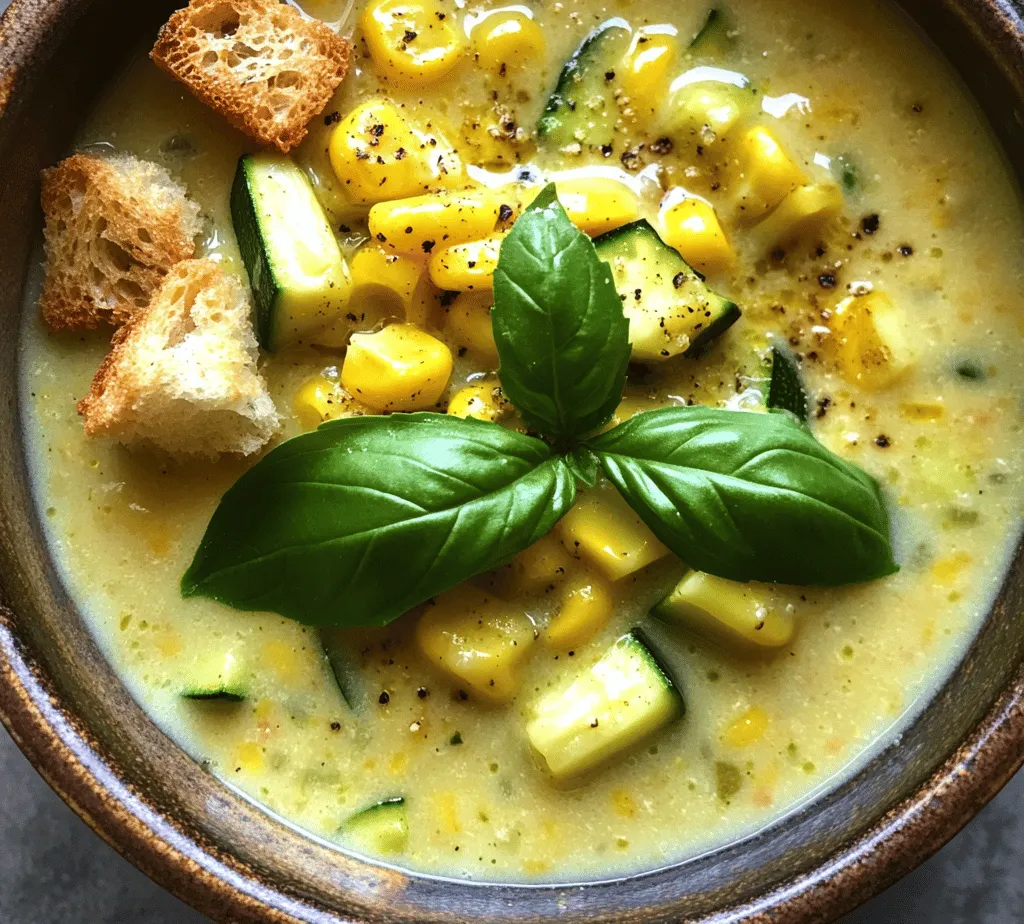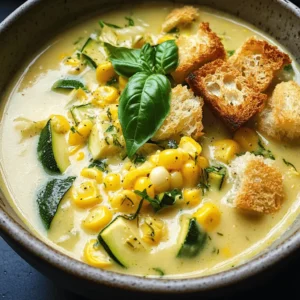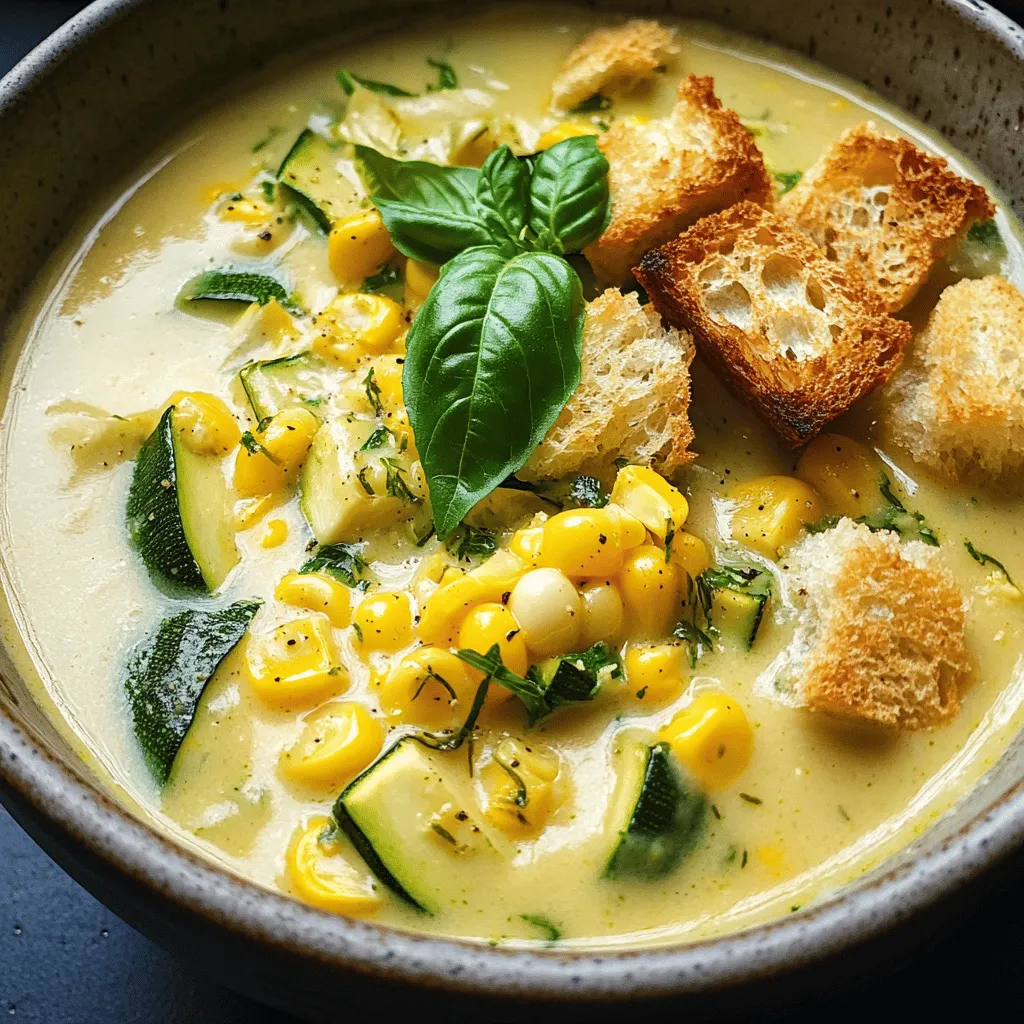As the sweltering days of summer roll in, there’s nothing quite like a refreshing bowl of chowder to celebrate the season’s bounty. Our Summer Corn and Zucchini Chowder is a delightful blend of sweet corn, tender zucchini, and aromatic herbs that captures the essence of summer in every spoonful. This recipe not only showcases vibrant seasonal ingredients but also delivers a hearty yet light dish that can be enjoyed on a warm day or a breezy evening.
The Importance of Seasonal Ingredients
Cooking with seasonal ingredients not only enhances the flavor of your dishes but also encourages a sustainable approach to eating. When you choose fresh produce that is in season, you are likely to enjoy better taste and nutritional value. Seasonal ingredients, like corn and zucchini, peak in flavor during the summer months, making them the perfect stars for our chowder.
Corn, harvested at its sweetest in the summer, brings a natural sweetness to the chowder, while zucchini adds a mild yet refreshing texture. Together, they create a beautiful harmony that embodies the spirit of summer. Plus, by utilizing ingredients that are at their peak, you are also supporting local farmers and reducing your carbon footprint.
The Appeal of a Hearty Yet Light Summer Chowder
Chowder is often associated with rich, heavy meals, but our Summer Corn and Zucchini Chowder breaks that mold. This recipe is designed to be both satisfying and light, making it an ideal dish for those hot summer days when you crave something comforting but don’t want to feel weighed down. The combination of fresh vegetables and a touch of cream provides a luxurious mouthfeel, while still allowing the fresh flavors to shine through.
This chowder is versatile—it can be served as a main course or as a side dish, and it pairs wonderfully with a crisp salad or warm crusty bread. Whether you’re hosting a summer gathering or enjoying a quiet dinner at home, this chowder will surely impress.
Understanding the Ingredients
To create the best Summer Corn and Zucchini Chowder, it’s crucial to understand the role of each ingredient in the recipe. Here’s a closer look at the key components that make this chowder not only delicious but also nutritious.
Fresh Corn: Nutritional Benefits and Peak Seasonality
Fresh corn is the star of this chowder, offering a burst of sweetness and crunch. It’s rich in fiber, vitamins B and C, and antioxidants, making it a healthy addition to your diet. When selecting corn, look for ears with bright green husks and plump kernels. The best time to enjoy fresh corn is during the summer months, typically from June to August, when it’s harvested at its peak ripeness. This ensures that every bite of your chowder is bursting with flavor.
Zucchini: Health Benefits and Texture in Chowder
Zucchini is another essential ingredient in our chowder. This versatile vegetable is low in calories yet high in vitamins A and C, making it a healthy choice for any meal. Its mild flavor and tender texture complement the sweetness of the corn perfectly. When cooked, zucchini becomes soft and adds a creamy element to the chowder without overpowering the other flavors. Choose small to medium-sized zucchinis for the best texture—larger zucchinis can become watery and may contain large seeds.
Aromatics: The Role of Onion and Garlic in Flavor Enhancement
Aromatic ingredients like onion and garlic play a crucial role in building the base flavor of the chowder. Onions add sweetness and depth, while garlic provides a warm, savory note that enhances the overall taste profile. Sautéing these aromatics releases their essential oils and flavors, creating a fragrant foundation for the chowder. For the best results, use yellow onions for their balanced sweetness and white or garlic for a punchier flavor.
Herbs and Spices: Importance of Thyme and Smoked Paprika for Depth of Flavor
Herbs and spices are key to elevating the flavor of your chowder. Fresh thyme is a classic herb that pairs beautifully with corn and zucchini, adding an earthy and slightly minty note. Smoked paprika, on the other hand, introduces a subtle smokiness that adds complexity to the dish. Together, these ingredients create a well-rounded flavor profile that enhances the natural sweetness of the vegetables.
Heavy Cream vs. Alternatives: Balancing Richness and Creaminess
While traditional chowders often rely on heavy cream for richness, our Summer Corn and Zucchini Chowder can be made lighter by using alternatives. You can opt for half-and-half, whole milk, or even plant-based options like coconut milk or cashew cream. These alternatives provide a creamy texture without overwhelming the dish. Experiment with different options to find the perfect balance of creaminess that suits your taste.
Step-by-Step Guide to Making Summer Corn and Zucchini Chowder
Creating the perfect Summer Corn and Zucchini Chowder involves a series of steps that focus on layering flavors and achieving the desired texture. Here’s a detailed guide to help you through the process.
Preparation of Ingredients: How to Efficiently Prepare Corn and Zucchini
Before you start cooking, it’s essential to prepare your ingredients properly. Begin by shucking the fresh corn, removing the husks and silk. To easily cut the kernels off the cob, stand the cob upright in a large bowl and use a sharp knife to slice downwards. This will help catch any kernels that might fly off. Next, wash and trim the ends of the zucchini, then chop it into bite-sized pieces. Having all your ingredients prepped and ready will streamline the cooking process.
Cooking Process Overview: Importance of Layering Flavors
The key to a flavorful chowder lies in the layering of flavors throughout the cooking process. Start with sautéing the aromatics, then gradually add the vegetables and broth, allowing each ingredient to contribute to the overall taste. This method ensures that the flavors meld together beautifully, resulting in a rich, satisfying chowder.
Sautéing Aromatics: Techniques for Enhancing Onion and Garlic Flavors
In a large pot or Dutch oven, heat a drizzle of olive oil over medium heat. Add the chopped onion and sauté for about 5 minutes, or until it becomes translucent. This process releases the natural sweetness of the onion, creating a flavorful base. Once the onion is softened, add minced garlic and sauté for an additional minute, stirring constantly to prevent burning. The aroma that fills your kitchen at this point will have everyone eagerly anticipating the chowder.
Adding Vegetables: Best Practices for Cooking Zucchini and Corn Together
After the aromatics are perfectly sautéed, it’s time to introduce the star ingredients: corn and zucchini. Add the corn kernels and chopped zucchini to the pot, stirring to combine. Allow the vegetables to cook together for about 5 minutes, stirring occasionally. This will help the zucchini release some of its moisture and allow the corn to caramelize slightly, enhancing the overall flavor of the chowder.
Simmering for Flavor Development: How Simmering Impacts the Final Taste
Once the vegetables are sautéed, it’s time to add the liquid. Pour in vegetable or chicken broth to cover the vegetables, then add fresh thyme and smoked paprika. Bring the mixture to a gentle simmer, allowing the flavors to meld together. Simmering for at least 15-20 minutes will help deepen the taste of the chowder, as the vegetables continue to soften and release their natural flavors.
Blending Techniques: Options for Texture in Chowder (Chunky vs. Smooth)
Depending on your preference, you can choose to blend the chowder for a smooth texture or leave it chunky for a heartier bite. If you prefer a creamier chowder, use an immersion blender to puree part of the soup directly in the pot. This will create a velvety base while still retaining some chunky pieces of corn and zucchini. If you prefer a chunkier texture, simply skip the blending step.
Finishing Touches: Importance of Seasoning and Adding Cream
As the chowder nears completion, it’s time to taste and adjust the seasoning. Add salt and pepper to enhance the flavors, and stir in your choice of cream or cream alternative for richness. Allow the chowder to simmer for an additional 5 minutes to incorporate the cream and heat it through. This final step is essential for achieving a well-balanced and delicious chowder that’s ready to be served.
By following these steps, you’ll create a luscious Summer Corn and Zucchini Chowder that captures the essence of summer while providing a comforting and satisfying meal. As you continue with the recipe, keep in mind the potential for flavor variations and customizations to make this chowder truly your own. Stay tuned for additional tips and tricks to elevate your chowder-making experience!

Herb Alternatives: Exploring Other Herbs That Complement the Chowder
When crafting your Summer Corn and Zucchini Chowder, the choice of herbs can significantly influence the flavor profile. While fresh basil and parsley are traditional favorites, several other herbs can elevate your dish. Consider these alternatives:
– Thyme: This herb adds an earthy note that complements the sweetness of corn beautifully. Use fresh thyme for the best flavor; a teaspoon of dried thyme will also suffice.
– Dill: If you’re looking for a light, slightly tangy taste, dill works wonders with the creamy texture of chowder. Its freshness pairs well with the vegetables, giving the dish a lovely aromatic lift.
– Chives: Known for their mild onion flavor, chives can provide a subtle kick. They are especially delightful as a garnish, adding a pop of color and flavor.
– Oregano: For a Mediterranean twist, oregano can be incorporated. It brings a warm, slightly peppery flavor that can enhance the overall depth of the chowder.
Feel free to mix and match these herbs based on your personal preference and what you have on hand. Each will impart a unique touch to your chowder, making it a versatile dish.
Adding Protein: Suggestions for Incorporating Chicken, Shrimp, or Beans
To make the chowder more filling, consider adding a protein source. Here are a few options:
– Chicken: Cooked, shredded chicken adds heartiness to your chowder. You can use rotisserie chicken for convenience—just stir it in during the last few minutes of cooking to heat through.
– Shrimp: For a seafood twist, add peeled and deveined shrimp. They cook quickly, so toss them in during the final five minutes of simmering. The shrimp will absorb the flavors of the chowder while adding a delightful texture.
– Beans: For a vegetarian option, white beans like cannellini or navy beans are excellent choices. They not only add protein but also a creaminess that complements the chowder. Simply rinse and drain canned beans before adding them to your pot.
Incorporating any of these proteins will enhance the chowder’s nutritional value and make it a more substantial meal.
Vegan Option: How to Adapt the Recipe for a Plant-Based Diet
If you’re following a plant-based diet, adapting the Summer Corn and Zucchini Chowder is simple. Here’s how you can make it vegan-friendly:
– Cream Substitute: Replace heavy cream with coconut milk or cashew cream. Both alternatives provide a rich texture while infusing a subtle flavor. To make cashew cream, soak raw cashews in water for a few hours, then blend with fresh water until smooth.
– Veggie Broth: Ensure you use vegetable broth instead of chicken broth to maintain the vegan integrity of the dish.
– Adjust Seasoning: When using plant-based cream, you may want to adjust the seasoning slightly, as these alternatives can be sweeter than dairy cream. Taste as you go and adjust with salt, pepper, and additional herbs.
By making these simple swaps, you can enjoy a delicious chowder that aligns with your dietary preferences without sacrificing flavor.
Spicing It Up: Ideas for Adding Heat with Peppers or Spices
If you enjoy a bit of heat in your chowder, there are several ways to spice things up:
– Jalapeños: Finely dice fresh jalapeños and sauté them with the onions and garlic at the beginning. For a milder flavor, remove the seeds and membranes before adding.
– Cayenne Pepper: A pinch of cayenne can go a long way. Start with a small amount and adjust to your desired spice level.
– Smoked Paprika: This adds a smoky flavor along with heat. It’s perfect for those who want flavor without overwhelming spice.
– Red Pepper Flakes: For a more straightforward approach, sprinkle some red pepper flakes into the chowder while it simmers. This allows you to control the spice level easily.
These additions can create a delightful contrast to the sweetness of the corn and zucchini, making your chowder even more exciting.
Serving Suggestions
Ideal Accompaniments: Pairing Chowder with Bread and Garnishes
When it comes to serving your Summer Corn and Zucchini Chowder, the right accompaniments can enhance the experience. Here are some suggestions:
– Crusty Bread: A warm, crusty baguette or a piece of sourdough is perfect for dipping. The bread soaks up the chowder, adding a delightful texture to each bite.
– Herb Garnishes: Fresh chives, parsley, or even a sprinkle of dill on top of each bowl adds a burst of color and freshness. A dollop of vegan sour cream or regular sour cream can also improve the presentation and add creaminess.
Presentation Tips: How to Serve for Visual Appeal
The way you present your chowder can elevate the dining experience. Here are some tips:
– Bowl Choice: Use wide, shallow bowls to showcase the ingredients. A contrasting color can make the chowder pop.
– Layering: When garnishing, layer the herbs and any additional toppings in the center of the chowder, allowing the vibrant colors to draw attention.
– Accompaniments on the Side: Serve the bread on a wooden board or a small basket lined with a cloth, creating a rustic presentation that complements the chowder.
Seasonal Pairings: Best Salads or Sides to Complement the Chowder
To create a well-rounded meal, consider pairing your chowder with a fresh salad or side dish. Here are some ideas:
– Mixed Green Salad: A simple salad with mixed greens, cherry tomatoes, and a light vinaigrette can provide a refreshing balance to the richness of the chowder.
– Cucumber Salad: A cool cucumber salad with a yogurt dressing can enhance the chowder experience, providing a crisp contrast.
– Grilled Vegetables: Seasonal grilled vegetables, such as asparagus or bell peppers, can add a smoky flavor that complements the corn and zucchini.
Nutritional Information
Breakdown of Calories, Fats, Proteins, and Carbohydrates per Serving
Understanding the nutritional profile of your chowder can help you make informed dietary choices. Here is a rough breakdown for one serving (based on a standard recipe):
– Calories: Approximately 250-300 calories
– Fats: 15-20 grams (depending on the use of heavy cream)
– Protein: 6-8 grams (higher if adding protein)
– Carbohydrates: 30-35 grams
These values may vary depending on ingredient choices and portion sizes.
Health Benefits of Key Ingredients: Corn, Zucchini, and Heavy Cream
– Corn: A great source of fiber and essential vitamins such as B vitamins, corn also provides antioxidants that support eye health.
– Zucchini: Low in calories and high in water content, zucchini is excellent for hydration and contains important nutrients like vitamin C and potassium.
– Heavy Cream: While heavier in calories, it provides a good source of calcium and vitamin A. Use in moderation to maintain a balanced diet.
Discussion on Portion Control and Healthy Eating
Portion control is essential for enjoying comfort food like chowder without overindulging. Consider serving smaller portions and pairing with a salad or light side dish to create a more balanced meal. Emphasizing fresh, seasonal ingredients also enhances the nutritional value of your meals.
Storing and Reheating Chowder
Best Practices for Storing Leftovers
If you have leftover chowder, proper storage is key to maintaining its flavor and texture. Here are some best practices:
– Cool Quickly: Allow the chowder to cool to room temperature before storing. This prevents bacterial growth.
– Airtight Containers: Store the chowder in airtight containers to keep it fresh. Glass containers are ideal as they don’t retain odors.
– Refrigerate: It can be stored in the fridge for up to three days.
How to Reheat Without Losing Flavor or Texture
When reheating chowder, it’s essential to do so gently to avoid curdling the cream. Here’s how:
1. Stovetop Method: Pour the chowder into a pot and heat over medium-low heat. Stir frequently to ensure even heating.
2. Microwave Method: If using a microwave, place the chowder in a microwave-safe bowl and cover it loosely. Heat in 30-second intervals, stirring in between until warmed through.
Freezing Options: What to Consider If Planning to Freeze
Freezing chowder is possible, but keep in mind:
– Texture Changes: Cream-based chowders can separate when frozen. If you plan to freeze, consider omitting the cream and adding it when reheating.
– Use Appropriate Containers: Use freezer-safe containers or bags to prevent freezer burn. Leave some space for expansion.
– Thawing: Thaw in the refrigerator overnight before reheating.
Conclusion
The Summer Corn and Zucchini Chowder is not just a dish; it’s a celebration of summer’s bounty, offering a delightful combination of flavors and textures that can be enjoyed in various ways. From experimenting with herbs and proteins to adapting it to suit vegan lifestyles, this chowder is adaptable to your tastes and dietary needs.
As you savor each spoonful, remember that this dish is a canvas for seasonal ingredients. Embrace the opportunity to incorporate fresh produce, and don’t hesitate to customize it according to what’s available at your local market.
Enjoy this comforting and satisfying chowder in the warmth of summer, and let it remind you of the joy of homemade cooking. Whether served on a quiet evening or at a gathering with friends, this chowder is sure to please and nourish. Happy cooking!



